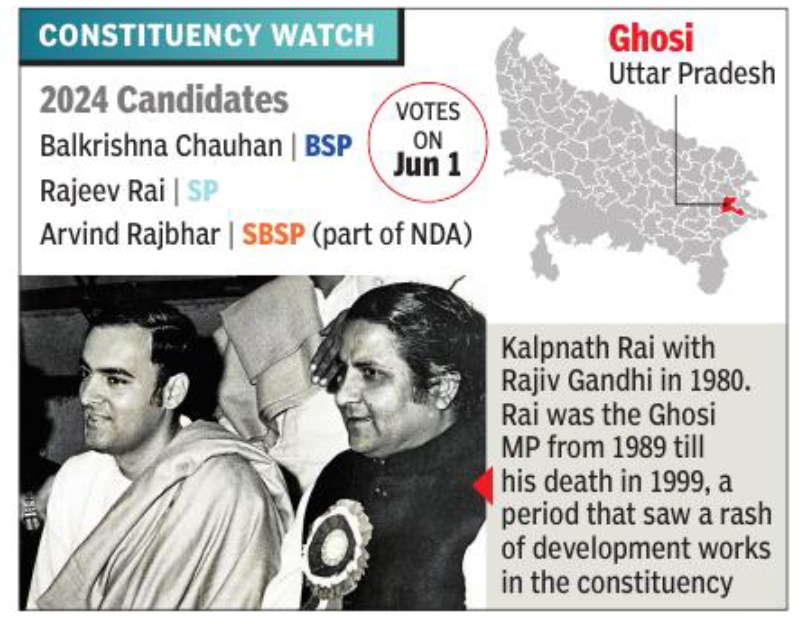Ghosi: political history
This is a collection of articles archived for the excellence of their content. |
A backgrounder
1989-2024 April
Rajiv Srivastava, May 29, 2024: The Times of India

From: Rajiv Srivastava, May 29, 2024: The Times of India
Ghosi (Mau) : Even 25 years after his death, no candidate addresses the people of Ghosi Lok Sabha constituency during the ongoing campaign without remembering Kalpnath Rai — a politician who continues to be synonymous with Mau.
“A four-time member of Lok Sabha and thrice of Rajya Sabha, Rai carried out development works in and around the district which continue to serve as benchmark. No other parliamentarian from Mau has been able to match the standard till now, let alone surpassing it,” says Virendra Kumar aka Virendra Engineer, once an associate of Rai.
“In contrast to Rai’s contribution, barely two months after the death of five-term MLA from Mau Sadar and mafia don-turned-politician Mukhtar Ansari, no sympathy wave is palpable in the constituency in general, and Mau Sadar assembly seat in particular. Behind Ansari’s success were an atmosphere of fear, backing from a particular community and the interests of a handful of people who got contracts,” says advocate Hari Kant Singh.
“It is hard to forget Kalpnath Rai’s name when the development of Mau is discussed. It is equally hard to pin-point development works undertaken during Ansari’s five terms, barring construction of roads, drains and setting up of transformers at some places in the constituency,” a govt official, listening to the conversation, chips in.
Development Man
Discussing the projects completed in Rai’s tenure, Virendra Engineer reels out the numbers: “Around 23 power sub-stations, 28 automatic telephone exchanges, and one of the first three 400 kVA power substations in the region were set up in Mau. The other two came up in Varanasi and Gorakhpur.” He points towards an 18-acre rose park across the MauBallia Road, adding that this is one of the last works done by ‘Rai Saheb’ before he died on June 4, 1999, at age 58.
“Rai also got a new DM residence built on a five-acre land, a new collectorate and court and over half-a-dozen modern guest houses. The Indian Institute of Seed Science and National Bureau of Agriculturally Important Microorganisms also came in Mau during his time,” Virendra says, adding that several politicians who came after Rai’s demise claimed they would take Mau to newer heights but none could.
“Mau had three railway overbridges at a time when even the state capital didn’t have one,” says Avinish Rai, from Kopa in Mau district. “Rai’s vision of development was such that Mau Sadar, which was not even a tehsil until 1987, became a district in 1988,” he adds.
“Politicians have been challenged by people to just get the infrastructure and buildings that Rai got constructed whitewashed and maintained during their fiveyear term. This itself will be a great service to the people of Mau. But even that hasn’t been done,” says Virendra. Shravan Kumar, another Rai admirer, says: “There are many people who have the vision but very few have a strong passion to work for their constituency.”
Tussle For Legacy
Ironically, candidates across party lines continue to try and show themselves as the “true heir” of Rai’s legacy. After the MP’s death in 1999, his second wife Sudha Rai and his son Siddharth contested against each other in the LS polls. But both lost. Sudha was fielded by Congress while Siddharth was a nominee of George Fernandes-led Samata Party, then part of NDA.
“While every second person in Mau talks about Rai’s achievements, his home in Semari Jamalpur wears a deserted look,” says Narendra Rai from Kalpnath’s village. “Not sure who all live there nowadays,” he adds.
Balkrishna Chauhan, who won the 1999 LS elections on a BSP ticket is once again the party candidate. He is pitted against SP-Congress alliance candidate Rajeev Rai and Suheldev Bhartiya Samaj Party (SBSP)-BJP alliance candidate Arvind Rajbhar. Arvind is the son of SBSP chief Om Prakash Rajbhar, who is a cabinet minister in the Yogi govt.
INDIA bloc’s Rajeev promises to develop Mau as Rai had done while Rajbhar and Chauhan say that they will fulfil “Rai’s dreams” of bringing unprecedented development to Ghosi. BSP has won the seat thrice — Chauhan in 1999, Dara Singh Chauhan, now a state minister, in 2009, and sitting MP Atul Rai in 2019. SP’s Chandradeo Prasad Rajbhar won the election in 2004 and BJP’s Hari Narayan Rajbhar bagged the seat in 2014.
Rai had won the Ghosi seat in 1989, 1991, 1996 and 1998. “Despite his achievements, even Rai had to sweat it out in Mau when it came to winning elections,” says Virendra, adding that the caste equations, which ruled then, dominate even to this day in this constituency.